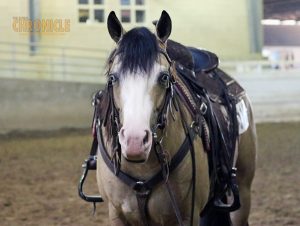Equine Science Update: Horses know when you are happy or sad
 From Equine Science Update, Posted by Mark Andrews
From Equine Science Update, Posted by Mark Andrews
New research shows that horses can distinguish between human expressions of happiness and sadness conveyed through facial movements or vocal tones. The study found that horses were more attracted by facial expressions of happiness than sadness, and they seemed more excited by the happy voices.
Emotions are a part of how people interact and talk to each other, and they could also play a role when we interact with other species.
Many types of animals, as diverse as orangutans and pigeons, are known to sense human emotions. Recently, studies on domestic animals such as dogs, cats, horses, and goats have shown they can recognize various human emotions shown on our faces. However, this area of research has mainly focused on two emotions: joy and anger. What about other emotions, such as sadness?
The study, conducted by an international research team from the National Research Institute for Agriculture, Food and Environment (INRAE) in France, the University of Tours in France and the University of Turku in Finland, observed and analysed horses’ behaviour when presented with human faces and voices expressing joy or sadness. The heart rate of the horses was also recorded during the experiment.
“Sadness is a particularly interesting emotion, because it is not only of negative valence – contrary to joy, which is positive – but it is also of low arousal. Previous studies have shown that horses react to high-arousal emotions like anger or joy. Could they also detect signals of sadness, a low-arousal emotion? We wanted to study whether horses can associate the vocal and facial signals of human sadness, as they can for joy and anger,” says the lead author of the study, Doctoral Researcher Plotine Jardat from the French National Institute for Agriculture, Food and the Environment and the University of Tours, France.
During the study, horses faced two screens. One showed a video of a person looking happy, while the other showed the same person looking sad. At the same time, a voice played, either sounding happy or sad.
The horses’ first look indicated they matched the face and voice expressing sadness or happiness. The researchers noticed that when the horses first saw the pictures, more of them spent longer looking at the picture that didn’t match the sound, compared to the one that did match.
So, when the horses looked at the pictures for the first time, they were surprised when a sad face was paired with a happy voice, and the other way around. The researchers suggest this implies that horses can link a human face and voice showing the same emotion, whether it’s sadness or happiness.
“This is interesting because it would mean that when horses observe our faces and hear our voices, they don’t just see and hear separate things, but they are able to match them across different modalities. You could imagine that they have a particular box in their mind labelled ‘human sadness’ containing the characteristics of both a human sad face and a human sad voice,” says Doctoral Researcher Océane Liehrmann from the University of Turku.
A similar setup has been used in several previous experiments by the team. Its purpose is to explore the animals’ mental processing of the images and sounds and their congruence. In the previous experiments on anger and joy as well as on the perception of adults and children, the horses reacted to the setup by looking more at the image that did not match the sound. The researchers believe that horses look more at the incongruent image because they are intrigued by the lack of correspondence between this image and what they hear.
After the first glance, the researchers saw that horses paid more attention to the screen displaying the happy face. They looked at it more often and for a longer time. Also, the horses’ heart rates went up more when they heard the happy voice compared to the sad one. This indicates that the horses were more alert and excited when the voice was joyful.
The researchers suggest three possible explanations for these findings. First, the horses might have been more interested in the happy images due to their movement, and more excited by the joyful voices because of the way they sounded, like changes in pitch. Second, the horses could have connected human happy faces with positive situations, making them want to look at these expressions that remind them of good memories. Third, the horses might have felt more positive when looking at the happy pictures and more stimulated when hearing joyful voices due to something called “emotional contagion.” This is when the emotions of an observer match the emotions of the one they’re observing. It has been seen in humans and primates, and studies suggest it could also happen between humans and other animals, like horses. This phenomenon is often seen as a basis for empathy.
“Overall, our study shows that horses can differentiate audible and visual signals of human joy and sadness, and associate the corresponding vocal and facial expressions. Horses were also more attracted and seemed more animated by joyful expressions, so people who interact with horses could benefit from expressing joy during these interactions,” Plotine Jardat concludes.
The researchers point out that further studies are needed to better understand horses’ perception of human sadness. In the future, they aim to find out, for example, whether horses can also differentiate sadness from other negative emotions, or whether sad expressions from humans can influence horses’ behaviour, especially during human-horse interactions.
For more details, see:
Horses discriminate between human facial and vocal expressions of sadness and joy.
Plotine Jardat, Océane Liehrmann, Fabrice Reigner, Céline Parias, Ludovic Calandreau & Léa Lansade
Anim Cogn (2023) 26, 1733–1742










